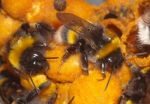(Press-News.org) Too cool and faint, many objects in the universe are impossible to detect with visible light. Now a Northwestern University team has refined a new technology that could make these colder objects more visible, paving the way for enhanced exploration of deep space.
"High performance infrared cameras are crucial for space exploration missions," said Manijeh Razeghi, the Walter P. Murphy Professor of Electrical Engineering and Computer Science in Northwestern University's McCormick School of Engineering and Applied Science. "By studying the infrared waves emitted by cool stars and planets, scientists are beginning to unlock the mysteries of these cooler objects."
Researchers have long looked to infrared waves to probe the depths of space. Infrared has a longer wavelength than visible light, so it can penetrate dense regions of gas and dust with less scattering and absorption. Current infrared detectors are typically built with mercury cadmium telluride, which works well with mid- and long-infrared wavelengths. However, this well-established technology demonstrates low uniformity and instability for infrared waves with very long wavelengths.
Published in the June 23 issue of Applied Physics Letters, Razeghi and her collaborators describe a new technology, which uses a novel type II superlattice material called indium arsenide/indium arsenide antimonide (InAs/InAsSb). The technology shows a stable optical response in regards to very long wavelength infrared light.
By engineering the quantum properties of the type II superlattice material, the team demonstrated the world's first InAs/InAsSb very long wavelength infrared photodiodes with high performance. The new detector can be used as an inexpensive and robust alternative to current infrared technologies.
"This material has emerged as the platform for the new generation of infrared detection and imaging," said Razeghi who leads McCormick's Center for Quantum Devices. "It has proved to have longer carrier lifetimes and promises a better controllability in epitaxial growth and simpler manufacturability."
Razeghi presented this work in a keynote talk at the International Society for Optical and Photonics Defense, Security, and Sensing conference in Baltimore in April and at the Microelectronics Workshop in Istanbul, Turkey last month.
INFORMATION: END
New technology illuminates colder objects in deep space
Northwestern researchers use a new material for more stable infrared detection
2014-07-09
ELSE PRESS RELEASES FROM THIS DATE:
Immune function predicts infection risk among child trauma patients
2014-07-09
Researchers studying critically ill children with traumatic injuries have identified an immune marker that predicts which patients are likely to develop a hospital-acquired infection. The study, led by clinician-scientists at Nationwide Children's Hospital and published online in June in the journal Shock, is part of several larger efforts that could lead to the clinical implementation of quick-turnaround immune function tests and treatments to prevent or reverse immune system damage following critical illness or injury in pediatric patients.
Hospital-acquired, or nosocomial, ...
BU researchers relate arrests with HIV risk environment
2014-07-09
Boston—Practices used in policing injection drug users in Russia might contribute to HIV transmission and overdose mortality.
A study, conducted by researchers from Boston University Schools of Medicine and Public Health, in collaboration with St. Petersburg Pavlov State University, sought to discover the effect police arrests had on the health outcomes of a cohort of HIV-positive people with lifetime of injection drug use.
Those who were arrested by police were more likely to share needles—increasing HIV transmission—and to overdose, according to the study published ...
Miriam Hospital study examines effect of depressed mood on pulmonary rehab completion
2014-07-09
PROVIDENCE, R.I. -- Researchers from The Miriam Hospital have found that people with Chronic obstructive pulmonary disease (COPD) who are also depressed have difficulty sticking to a pulmonary rehabilitation program. This appears to be particularly true for women, and screening and brief treatment of depression should be considered as part of treatment. The study and its findings are published in print in Respiratory Medicine.
Chronic obstructive pulmonary disease is a common and often disabling inflammatory lung disease characterized by a progressive airway obstruction ...
Bee foraging chronically impaired by pesticide exposure: Study
2014-07-09
A study co-authored by a University of Guelph scientist that involved fitting bumblebees with tiny radio frequency tags shows long-term exposure to a neonicotinoid pesticide hampers bees' ability to forage for pollen.
The research by Nigel Raine, a professor in Guelph's School of Environmental Sciences, and Richard Gill of Imperial College London was published July 9 in the British Ecological Society's journal Functional Ecology.
The study shows how long-term pesticide exposure affects individual bees' day-to-day behaviour, including pollen collection and which flowers ...
Adults with special needs see gains, challenges with long term oral care
2014-07-09
BOSTON (July 9, 2014) — A retrospective study conducted by researchers at Tufts University School of Dental Medicine and colleagues reports that among adults with intellectual and developmental disabilities, the likelihood of having cavities decreased as the number of years receiving dental care increased. The findings, published in the July/August issue of Special Care in Dentistry, may help improve interventions designed to address the oral health of individuals in this population.
The researchers reviewed the dental records of 107 patients at one of the eight clinics ...
Most prescription labels fail to meet guidelines, risking dosage errors
2014-07-09
Small print and poor printing on prescription labels handed out by pharmacists may be misread and may lead to errors in taking medication, according to new research by the University of Waterloo and CNIB (Canadian National Institute for the Blind).
The study, published recently in the Canadian Pharmacists Journal, found that labels on prescription medications dispensed by pharmacies do not consistently follow professionally recommended guidelines for legibility.
By simply following recommended guidelines for font size, use of bolding, justification, sentence case and ...
Penn study finds living kidney donation does not increase risk of death or heart disease for older
2014-07-09
PHILADELPHIA – Previous studies linking older age with kidney and heart disease have raised concerns about the safety of living kidney donation among older adults. However, in the first study to look closely at this issue, researchers at the Perelman School of Medicine at the University of Pennsylvania report that older kidney donors (55 years and above) enjoy similar life expectancy and cardiovascular health as very healthy older people who did not donate their kidneys. In light of the ever increasing organ transplant waitlists, the authors of the study hope the results ...
Projecting a 3-dimensional future
2014-07-09
Since the 1960s, theatergoers have shelled out for crude 3-D glasses, polarized glasses, and shutter glasses to enhance their viewing experience. These basic devices, used to trick the brain into perceiving an artificial three-dimensional reality, may soon be rendered obsolete with the introduction of new holography technology developed by Tel Aviv University researchers.
TAU doctoral students Yuval Yifat, Michal Eitan, and Zeev Iluz have developed highly efficient holography based on nanoantennas that could be used for security as well as medical and recreational purposes. ...
Shark teeth analysis provides detailed new look at Arctic climate change
2014-07-09
A new study shows that some shark species may be able to cope with the rising salinity of Arctic waters that may come with rising temperatures.
The Arctic today is best known for its tundra and polar bear population, but it wasn't always like that. Roughly 53 to 38 million years ago during what is known as the Eocene epoch, the Arctic was more similar to a huge temperate forest with brackish water, home to a variety of animal life, including ancestors of tapirs, hippo-like creatures, crocodiles and giant tortoises. Much of what is known about the region during this period ...
Making a more healthful, low-fat hot dog without giving up texture
2014-07-09
With grilling season upon us, many backyard cooks are turning to more healthful alternatives to their savored but fatty hot dogs. But low fat can sometimes mean low satisfaction. Now researchers are reporting new progress toward addressing the texture problem in low-fat wieners that are made with olive oil rather than pork fat. Their study was published in ACS' Journal of Agricultural and Food Chemistry.
Ana M. Herrero and colleagues note that hot-dog consumers have come to expect just the right amount of chewiness and springiness, among other things, from their beloved ...
LAST 30 PRESS RELEASES:
Ants: An untapped resource in the development of antibiotics?
Archaeologists use AI to create prehistoric video game
Mitochondria migrate toward the cell membrane in response to high glucose levels
Tiny viral switch offers hope against drug-resistant bacteria
Most parents aware of early peanut introduction guidelines, but confused about details
HPV vaccine can protect against severe lesions of the vulva and vagina
Virtual care provision and emergency department use among children and youth
Quadrivalent HPV vaccine and high-grade vulvovaginal lesions
Insights into dry eyes gained from stem cell-derived tear glands
Researchers identify 166 human pluripotent stem cell lines available for use in clinical applications
Europa Clipper instrument uniquely observed interstellar comet 3I/ATLAS
UN University Report challenges climate change as sole trigger of Syrian Civil War, exposing governance failures in drought response
Real estate investment trust (REIT) acquisition associated with hospital closure and bankruptcy
New Raman imaging system detects subtle tumor signals
Boston Children’s receives a $7.5 million grant from Aligning Research to Impact Autism (ARIA) to provide clinical research coordination for the IMPACT Network
Spray-on antibacterial coating offers new protection for plants against disease and drought
ESMT Berlin study: What makes a first offer successful in negotiations
Groundbreaking ceremony marks the beginning of CTAO-South Array construction in Chile
Why swearing makes you stronger
What prevents more cancer patients from enrolling in potentially life-saving clinical trials?
UK’s worst-case climate risks laid bare for lawmakers
A decline in churchgoing linked to more deaths of despair
TAMEST announces Maralice Conacci-Sorrell, Ph.D., UT Southwestern Medical Center, as 2026 Mary Beth Maddox Award & Lectureship Recipient
Global study to evaluate whether dengue outbreaks can be anticipated earlier
Chonnam National University researchers propose innovative voltage-loop control for power factor correction
Accelerating next-generation drug discovery with click-based construction of PROTACs
Detecting the hidden magnetism of altermagnets
$7M gift supports health research, engineering and athletics at UT San Antonio
NU-9 halts Alzheimer’s disease in animal model before symptoms begin
Hospitals acquired by real estate investment trusts associated with greater risk of bankruptcy, closure
[Press-News.org] New technology illuminates colder objects in deep spaceNorthwestern researchers use a new material for more stable infrared detection

